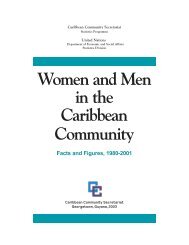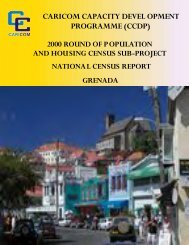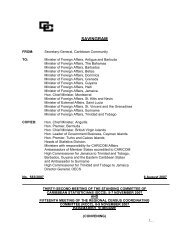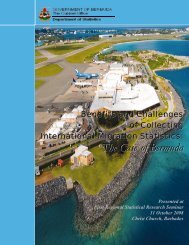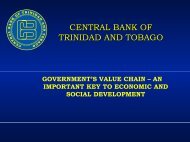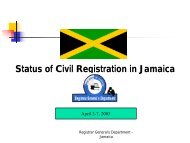CARICOM CAPACITY DEVELOPMENT PROGRAMME (CCDP)
CARICOM CAPACITY DEVELOPMENT PROGRAMME (CCDP)
CARICOM CAPACITY DEVELOPMENT PROGRAMME (CCDP)
You also want an ePaper? Increase the reach of your titles
YUMPU automatically turns print PDFs into web optimized ePapers that Google loves.
National Census Report 2001, St. Vincent and the Grenadinesage group 45-64 while there were 1 502 cases among those 65 years or older. Those in the 25 to44 age group accounted for 14.39 per cent (527 cases), children (9 cases) and youths (39 cases)together accounted for 1.31 per cent of the reported cases. These figures indicate that thepopulation is mainly affected by Type II Diabetes, which is the adult onset type; and that Type IDiabetes, which is the juvenile onset type, is minimal. The females accounted for 66.39 per cent(2 432 cases) of the reported cases of Diabetes. The corresponding rate was even higher amongthe elderly (Tables 7.3(a), 7.3(b)).According to the MOH data, diabetes is the third leading illness for clinic attendances, with themajority of the reported cases made by females (75.2 per cent). The distribution by sex hasremained the same from 2001 to 2003. The MOH Report also noted that a high percentage thatattended the clinics had both diabetes and hypertension. The combined diabetes/hypertensionwas ranked as the second highest for clinic attendances in 2003. The females outnumbered themales three to one and attendances for this combined illness were highest in Calliaqua,Kingstown and Cedars health districts. This finding is supported by the census data whichindicates that 53.21 per cent of those who reported having diabetes also reported havinghypertension; with 41.35 per cent of males compared to 59.21 per cent of females have bothdiabetes and hypertension.Diabetes is a disease in which blood glucose levels are above normal and the body either doesnot make enough insulin or cannot use its own insulin as well as it should to manage the bloodsugar level. Unmanaged diabetes can cause serious health complications including heart disease,blindness, kidney failure, and lower-extremity amputations. The census data indicate that 5.41per cent of those with diabetes also had heart disease and that females were more likely than themales to have diabetes and heart disease, 5.8 and 4.63 per cent respectively. Less than two percent (1.45 per cent) had both diabetes and kidney disease.7.5.5 Other IllnessesA significant number of the population also reported that they suffered from illnesses related toheart (950), sickle cell (853), kidneys (445), stroke (355) and cancer (164) 22 . Females accounted22 Data on Cancer not available in the table 7.3 (b)97



